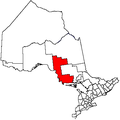Gros Cap Indian Village 49A | |
|---|---|
| Gros Cap Indian Village Indian Reserve No. 49A | |
| Coordinates: 47°59′N84°54′W / 47.983°N 84.900°W | |
| Country | |
| Province | |
| District | Algoma |
| First Nation | Michipicoten |
| Area | |
| • Land | 0.05 km2 (0.02 sq mi) |
Gros Cap Indian Village 49A is a First Nations reserve [1] which is surrounded by Wawa, Ontario, but almost borders Gros Cap 49. It is one of the reserves of the Michipicoten First Nation.

